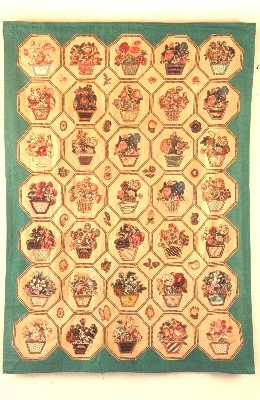Quilt No.304ASA - Art Gallery of South Australia
Owner:
Art Gallery of South Australia
Location:
SA Adelaide
Maker
Maker:
Jane Judd
Made in
ENGLAND
Patterms
Date:
pre 1850
Description:
Quilt of cotton and linen fabrics has pots of flowers appliqued on to a cream background with hexagonal 'paths' of a striped fabric in between. The appliqued flowers are in broderie perse - flowers cut from floral patterned fabric. The diamond shapes in between the hexagons have single flowers in broderie perse. Border and backing is 20th century, of mid green cotton. Handsewn,
2230 x 1630mm
2230 x 1630mm
History:
Made by Jane Judd in Great Britain in the early 19th century. The quilt was brought to South Australia in the 19th century by the maker's great grand-daughter Katherine Helroyd, and continued to stay in the family, until donated to the Art Gallery of South Australia, Adelaide, in 1994 by Diana Tostevin.
947A60
Story:
Jane Judd's husband was taken prisoner during the American Wars of Independence and after his return to England 12 years later she made a patchwork of his shirts and dyed them with saffron. The broderie perse quilt contains early 19th century fabrics, so was either made later in her life, or has had additional fabrics added. The quilt remained in the family of the maker until it was donated to the Art Gallery of South Australia.
Related Quilts:
Wholecloth pram quilt with a top of pink cotton sateen, and the reverse is a more finely woven, ivory, fabric. All over quilting design as main feature, with stylised hearts, leaves and cross hatching. The padding is cotton batting. 870 x 660 mm.
Hand stitched, cotton, appliquéd, quilt in a flower pattern on a plain background. Colours are shades of green, apricot and browns. This quilt was known as a 'Bride's Quilt'. Padding is thought to be layers of white fabric raised almost like a wadding. The backing is cotton material. 2470 x 2020 mm.
Wholecloth quilt made of red floral crinoline cotton material. Quilting is in vertical rows, alternating cables with orange peel patterns. Padding is of cotton flock. Backing is of white cotton. Quilt is edged with a self fabric ruffle on three sides. Hand sewn.
2236 x 2236mm
2236 x 2236mm
Wholecloth Greek quilt. "The fabric is a beautiful silk satin with a formal pattern of soft yellows and pinks on a turquoise background. Surrounding this is a 40cm wide border also of silk satin (cerise coloured). The quilt is machine pieced but hand quilted. The method of quilting is very interesting. A thick cream twist has been used and at first glance it seems that the quilt is tied as there are long pairs of stitches with gaps of about 4cm between them. However, either a long needle was used to make a pair of stitches OR each side may have been quilted separately with the needle only going half way into the wadding which is about 2 cms thick." [Kereake Wray] The padding is kapok approx 2 cm thick and the backing is deep coral pink satin. 2200 x 1960 mm.
" A coverlet of 7 pieces of cream muslin. The edges of the work are secured at the top and sides with bands of green and floral strips. The lower edge has been turned and hemmed. The 'quilt' is highly decorated with bands and diamonds of appliqué fabric. The upper centre field is appliquéd with images depicting Adam and Eve in the Garden of Eden surrounded by trees and a variety of animals and insects. In the centre is a smaller appliquéd image of the manger with mangel and cows. The quilt is not signed or dated, but each of the imaged areas is accompanied by a descriptive text. The writing is executed in black chain stitch. Beads and sequins have been used to depict the eyes of some of the animals in the Garden of Eden. As with all of Mary Jane Hannaford's quilts all work is hand sewn and quite crude and coarse in execution. The quilt is not padded or lined." [NGA] 1810 x 1590mm
Durham quilt made of cotton sateen, mainly gold on one side and yellow green on the other. Top, pillow fold, has been removed. The straight sides have tiny pin stripe added border. The quilting pattern is large tree of life (palm like), swags and cable on top and bottom border. Fill in is slightly elongated diamonds. 1880 x 1520mm








